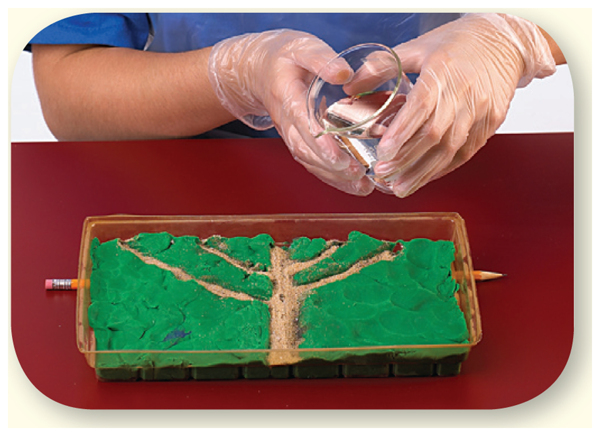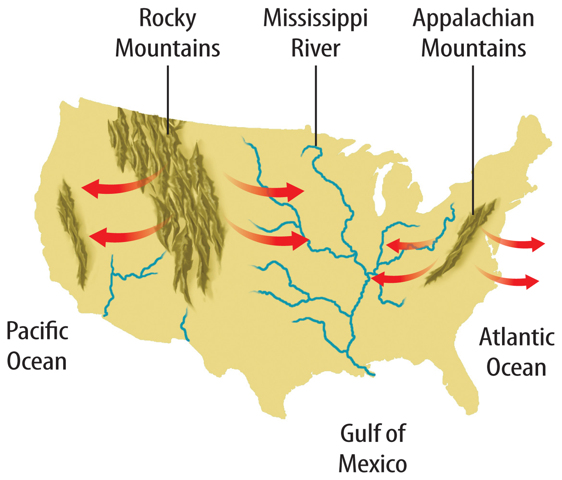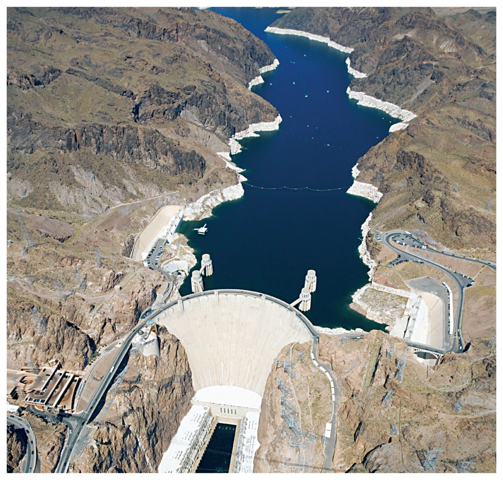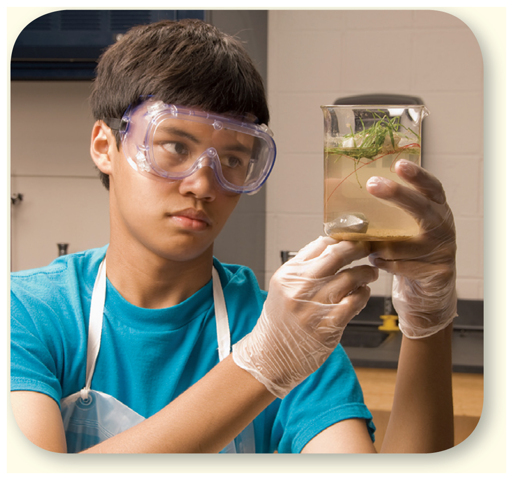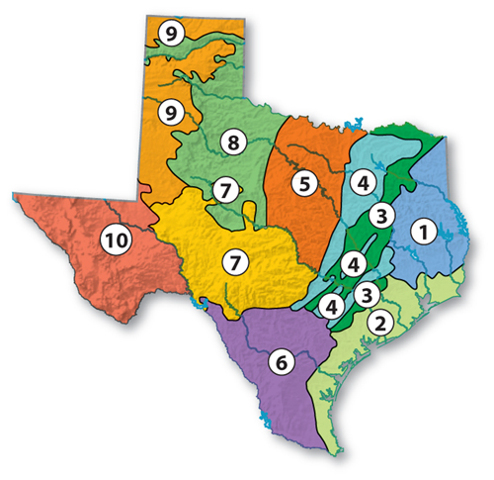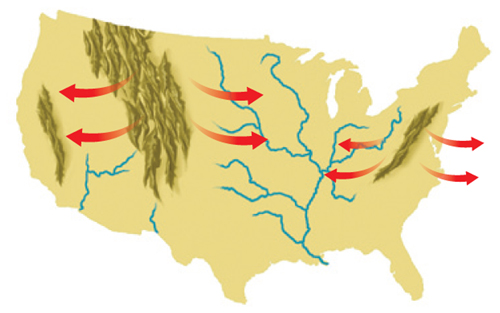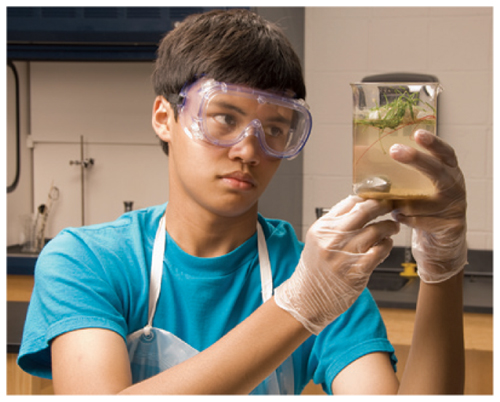Weathering, Erosion, and Deposition
Games Outrageous Acts of science Strangest weather on earth Erosion Landslide
Games Outrageous Acts of science Strangest weather on earth Erosion Landslide
Where’s the water?
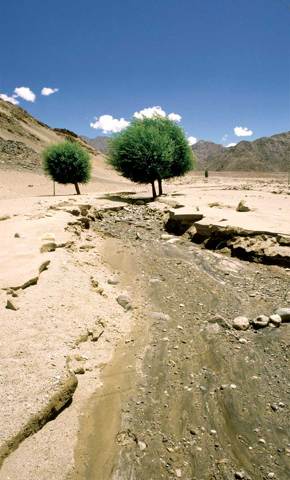
Does this look like a river to you? It may not have water in it now, but sometimes it does. How do weather patterns affect the land surface and the plants and animals that live there?
 Launch Lab: Can storms be beneficial?
Launch Lab: Can storms be beneficial?




What will happen to the water and sandy river bed of this model if it rains for a long period of time?
What would happen if the model was tilted? How does the degree of incline effect the sandy bottom of a river?

Key Concepts
ESSENTIAL QUESTIONS
ESSENTIAL QUESTIONS
• How does weather affect ecoregions?
• What is a watershed?
• How does human activity affect a watershed?
• What is a watershed?
• How does human activity affect a watershed?
• How do Weathering, Erosion, and Deposition effect ecosystems?
 Launch Lab: Can storms be beneficial?
Launch Lab: Can storms be beneficial?



Severe weather can be destructive. But some storms, including thunderstorms and even hurricanes, can be beneficial, too. How can a storm have a positive effect on an ecoregion?
What will happen to the water and sandy river bed of this model if it rains for a long period of time?
What would happen if the model was tilted? How does the degree of incline effect the sandy bottom of a river?
Think About This
1. What happened when you poured the second amount of water into the river? Be specific.
2. What happened to the sand? How might this be beneficial to the riverbank in the ecoregion?
3. Key Concept How do you think severe weather could affect the rivers in an ecoregion?
Surface Water and Groundwater
The amount of water available to an area is an important feature of an ecoregion. How much precipitation falls and where it drains are factors that determine which organisms can live in an area. Precipitation that soaks into the cracks and pores beneath Earth’s surface is groundwater. Surface water is the water that fills lakes and rivers. Humans rely on groundwater and surface water to irrigate crops, provide drinking water, for recreation, and for other uses.
3.  Reading Check How do surface water and groundwater differ?
Reading Check How do surface water and groundwater differ?
 Reading Check How do surface water and groundwater differ?
Reading Check How do surface water and groundwater differ?
Watersheds
Water that falls on land flows in streams and rivers and drains into a larger body of water. A watershed is an area of the land where all runoff drains to the same body of water. High points, such as mountains, form boundaries between different watersheds, as shown in Figure 3. All organisms in a watershed are affected by the amount and the availability of water in the watershed.
4. Key Concept Check What is a watershed?
Figure 3 Water on the two sides of a boundary flows to different places. Water that flows to the same area is part of a particular watershed.
How Watersheds Can Change
Watersheds change naturally over time. Over millions of years, the shape of the land changes. This can change the direction water flows. In a shorter time, floods can carry nutrients and sediments to new parts of a watershed.
Human Impacts Humans also can change watersheds. As shown in Figure 4, people build dams that change the flow of rivers. Lakes called reservoirs form behind the dams. People use the water in reservoirs to irrigate farms and to provide water for towns and cities. Changing the flow of rivers can change the watershed—and the organisms that live there. Sometimes these changes can be permanent.
Changing the Flow of Rivers Built to make reservoirs or control flooding, dams on a river prevent water from flowing through the watershed. That means areas downstream do not have as much water as they once did. This can change ecoregions.
Irrigation To provide crops with needed water, some farmers irrigate land with groundwater pumped from wells. Others use water from trenches that carry water to crops.
Water Pollution Rivers and lakes can be affected by pollution. If the water in a watershed is polluted, it can harm organisms living in the watershed. Pollutants can come from factories that release harmful chemicals into a river. Or, water flowing through farms or towns can pick up pesticides or oil and carry it into lakes and rivers. These pollutants will pass through layers of soil and rocks, but some will still make it into the groundwater. This groundwater is what we depend on for our drinking water. If pollution is not controlled or stopped, then the groundwater and drinking supply will be polluted and will not be suitable for consumption.
5. Key Concept Check How can humans change watersheds?
Figure 4 This dam allows the reservoir to fill with water. The water is essential for people living in this region.
6.  Visual Check Where is the reservoir?
Visual Check Where is the reservoir?
 Visual Check Where is the reservoir?
Visual Check Where is the reservoir?
Weathering, Erosion, and Deposition
As water, wind, and ice move across Earth, they can break down rock in a process called weathering. The rate of weathering depends on the temperature and humidity in an area. Typically, weathering occurs more quickly in hot, humid areas, such as a rain forest. Weathering occurs more slowly in cold, dry areas. Look back at the map of Texas ecoregions in Figure 2. Where do you think weathering occurs quickly? Where do you think weathering occurs slowly?
In Texas, weathering would likely occur rapidly along the southeastern coast, where temperatures and humidity are high. The coast is also subject to weathering from the Gulf of Mexico and severe weather events, such as hurricanes. The west Texas ecoregions contain mostly desert areas, where temperatures are high and humidity is low. Weathering would likely be slower there than in other areas of the state.
After rock is broken down into smaller pieces, or sediment, water, wind, ice, and gravity can move sediment from place to place. The process of moving weathered material from one location to another is called erosion. Erosion can change ecoregions because it can change the landscape, change a river’s course, or sweep beaches into the ocean.
As water slows, eroded material is laid down and settles in a process called deposition. The cycle of erosion and deposition can move fertile soil to new areas, build barrier islands, and build and move sand dunes. Erosion and deposition also can move pollutants or cover up areas where plants and animals once lived. Erosion and deposition are natural processes, but the way humans use land can increase or decrease the impact of these processes. For example, erosion increases when trees, grasses and other natural vegetation are cleared from the land. People can plant trees, shrubs, or grasses to help reduce erosion.
In Texas, weathering would likely occur rapidly along the southeastern coast, where temperatures and humidity are high. The coast is also subject to weathering from the Gulf of Mexico and severe weather events, such as hurricanes. The west Texas ecoregions contain mostly desert areas, where temperatures are high and humidity is low. Weathering would likely be slower there than in other areas of the state.
After rock is broken down into smaller pieces, or sediment, water, wind, ice, and gravity can move sediment from place to place. The process of moving weathered material from one location to another is called erosion. Erosion can change ecoregions because it can change the landscape, change a river’s course, or sweep beaches into the ocean.
As water slows, eroded material is laid down and settles in a process called deposition. The cycle of erosion and deposition can move fertile soil to new areas, build barrier islands, and build and move sand dunes. Erosion and deposition also can move pollutants or cover up areas where plants and animals once lived. Erosion and deposition are natural processes, but the way humans use land can increase or decrease the impact of these processes. For example, erosion increases when trees, grasses and other natural vegetation are cleared from the land. People can plant trees, shrubs, or grasses to help reduce erosion.
 Reading Check How can erosion and deposition affect ecoregions?
Reading Check How can erosion and deposition affect ecoregions?
1
WORD ORIGIN
erosion
from Latin erosionem, means “gnaw away”
from Latin erosionem, means “gnaw away”
1
 MiniLab: How can watersheds be cleaned up?
MiniLab: How can watersheds be cleaned up?



You might have seen an oil leak in a driveway or a parking lot. What happens to this oil when it rains? It likely enters a nearby watershed and causes pollution. How can you model pollution of a watershed, and how can you clean up the mess?
1. Read and complete a lab safety form.
2. Pour water into a large beaker until the beaker is half full.
3. Choose five watershed pollutants, and add them to the water. You may use a plastic spoon to stir the pollutants.
4. Exchange models with another group.
5. Use cleanup tools to remove the pollutants from the other group’s water.
6. In your Science Journal, describe how easy—or not—each pollutant was to remove.
Analyze and Conclude
1. Classify each pollutant in the other group’s watershed as either harmful or not harmful. Support your answer.
2. Infer Suppose you could remove all of the pollutants from the water. Would the water then be clean? Why or why not?
3. Key Concept How does human activity affect a watershed?
Lesson Review
Visual Summary
An area that has a distinct group of plants, animals, and other organisms is an ecoregion. Organisms in an ecoregion have adaptations for a particular climate.
All water that falls on land and drains to the same area is part of the same watershed. Natural events and humans can both affect a watershed.
Pollution from humans can get into surface water and groundwater.
Lesson Assessment
Use Vocabulary
1. Use the terms erosion and deposition in a sentence.
2. Water that fills lakes, rivers, and streams is called __________.
3. Define climate in your own words.
Understand Key Concepts
4. Which is NOT an ecoregion in Texas?
A. desert
B. plains
C. prairie
D. tundra
5. Compare the effects of human activity and natural processes on watersheds.
6. Relate How are groundwater and surface water related to a watershed?
7. The distribution of ecoregions on Earth depends on
A. air pressure.
B. climate.
C. convection.
D. tornadoes.
Interpret Graphics
8. Organize Copy the graphic organizer below. List three ways humans can impact watersheds.


9. Explain Describe how the feature pictured here changes the watershed.
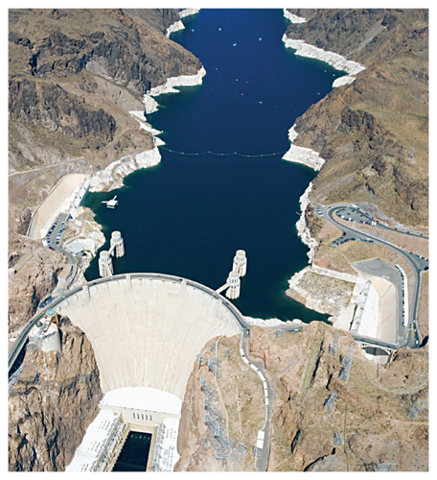
ThinkStock/SuperStock
Critical Thinking
10. Infer What positive and negative effects could heavy rainfall have on a desert ecoregion?
11. Hypothesize Describe two ways water pollution released from a factory into a small stream
could travel through a watershed.
could travel through a watershed.
12. Infer What might be some effects of soil erosion in a heavily populated area?
13. What are some of the differences between long-term and short-term severe weather effects?
14. What effect do weather patterns have on ecoregions?
Texas Essential Knowledge and Skills Copyright © 2011. Texas Education Agency. All Rights Reserved
